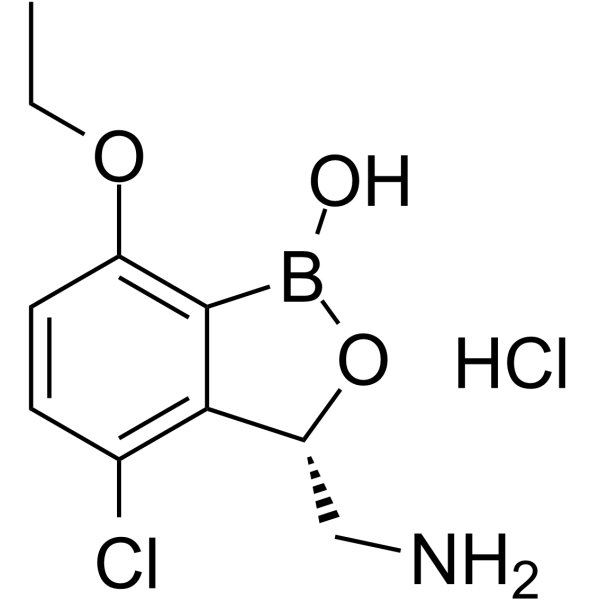1364683-67-9
| Name | LeuRS-IN-1 hydrochloride |
|---|
| Description | LeuRS-IN-1 hydrochloride is a potent, orally active M. tuberculosis leucyl-tRNA synthetase (M.tb LeuRS) inhibitor. LeuRS-IN-1 hydrochloride has IC50 and Kd values of 0.06 μM, 0.075 μM for M.tb LeuRS, respectively[1]. LeuRS-IN-1 hydrochloride inhibits human cytoplasmic LeuRS (IC50=38.8 μM), and HepG2 protein synthesis (EC50=19.6 μM)[2]. |
|---|---|
| Related Catalog | |
| Target |
M.tb LeuRS:0.06 μM (IC50) M.tb LeuRS:0.075 μM (Kd) human cytoplasmic LeuRS:38.8 μM (IC50) HepG2 protein synthesis:19.6 μM (EC50) |
| In Vitro | LeuRS-IN-1 (compound 13) hydrochloride has a MIC value of 0.02 μg/mL for M.tb H37Rv bacteria[1]. LeuRS-IN-1 (compound 3a) (48 h) hydrochloride induces HepG2 cell toxicity with an EC50 value of 65.8 μM[2]. |
| In Vivo | LeuRS-IN-1 (100 mg/kg; orally daily for 14 days) hydrochloride reduces lung CFU value in acute tuberculosis (TB) mice[1]. LeuRS-IN-1 (33 mg/kg; orally 5 days a week for 4 weeks) hydrochloride reduces lung and spleen CFU values in chronic TB mice[1]. Murine pharmacokinetic parameters[1]: Administration Dose (mg/kg) Cmax (μg/ml) at 5 min CL (ml/h/kg) Vss (ml/kg) MRT (h) AUC0-∞ (h · μg/ml) α-t1/2 (h) (% AUC) β-t1/2 (h) (% AUC) i.v. 30 13.6 582 3,142 5.4 51.6 0.10 (2) 3.83 (98) Administration Dose (mg/kg) Cmax (μg/ml) Tmax (h) AUC0-24 (h · μg/ml) Terminal t1/2 (h) Bioavailability (%) (h · μg/ml) Mouse PPB (%) p.o. 30 6.4 0.25 47.5 3.1 9.2 23 Animal Model: Murine GKO (C57BL/6-Ifngtm1ts) model of acute TB[1] Dosage: 100 mg/kg Administration: Orally daily for 14 days after 10 days of infection (start) with M. tuberculosis Erdman. Result: Reduced lung CFU value in mice. Animal Model: Murine BALB/c model of chronic TB infection[1] Dosage: 33 mg/kg Administration: Orally 5 days a week for 4 weeks after infection with M. tuberculosis Erdman with a low-dose aerosol 21 days prior (start). Result: Reduced lung and spleen CFU values in mice. |
| References |
| Molecular Formula | C10H14BCl2NO3 |
|---|---|
| Molecular Weight | 277.94 |
